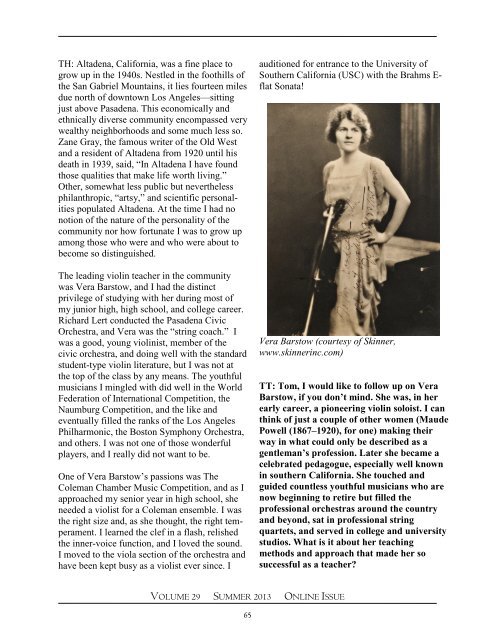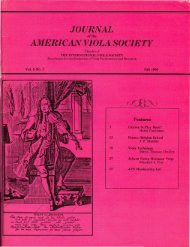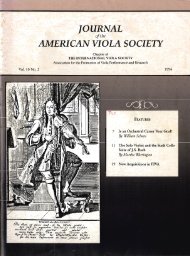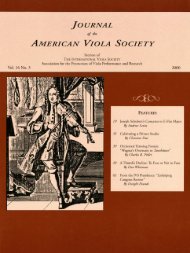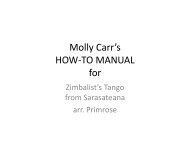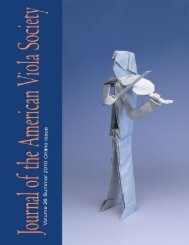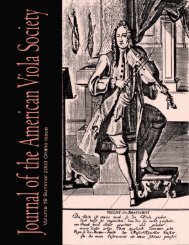Summer 2013 - The American Viola Society
Summer 2013 - The American Viola Society
Summer 2013 - The American Viola Society
You also want an ePaper? Increase the reach of your titles
YUMPU automatically turns print PDFs into web optimized ePapers that Google loves.
TH: Altadena, California, was a fine place to<br />
grow up in the 1940s. Nestled in the foothills of<br />
the San Gabriel Mountains, it lies fourteen miles<br />
due north of downtown Los Angeles—sitting<br />
just above Pasadena. This economically and<br />
ethnically diverse community encompassed very<br />
wealthy neighborhoods and some much less so.<br />
Zane Gray, the famous writer of the Old West<br />
and a resident of Altadena from 1920 until his<br />
death in 1939, said, “In Altadena I have found<br />
those qualities that make life worth living.”<br />
Other, somewhat less public but nevertheless<br />
philanthropic, “artsy,” and scientific personalities<br />
populated Altadena. At the time I had no<br />
notion of the nature of the personality of the<br />
community nor how fortunate I was to grow up<br />
among those who were and who were about to<br />
become so distinguished.<br />
<strong>The</strong> leading violin teacher in the community<br />
was Vera Barstow, and I had the distinct<br />
privilege of studying with her during most of<br />
my junior high, high school, and college career.<br />
Richard Lert conducted the Pasadena Civic<br />
Orchestra, and Vera was the “string coach.” I<br />
was a good, young violinist, member of the<br />
civic orchestra, and doing well with the standard<br />
student-type violin literature, but I was not at<br />
the top of the class by any means. <strong>The</strong> youthful<br />
musicians I mingled with did well in the World<br />
Federation of International Competition, the<br />
Naumburg Competition, and the like and<br />
eventually filled the ranks of the Los Angeles<br />
Philharmonic, the Boston Symphony Orchestra,<br />
and others. I was not one of those wonderful<br />
players, and I really did not want to be.<br />
One of Vera Barstow’s passions was <strong>The</strong><br />
Coleman Chamber Music Competition, and as I<br />
approached my senior year in high school, she<br />
needed a violist for a Coleman ensemble. I was<br />
the right size and, as she thought, the right temperament.<br />
I learned the clef in a flash, relished<br />
the inner-voice function, and I loved the sound.<br />
I moved to the viola section of the orchestra and<br />
have been kept busy as a violist ever since. I<br />
auditioned for entrance to the University of<br />
Southern California (USC) with the Brahms E-<br />
flat Sonata!<br />
Vera Barstow (courtesy of Skinner,<br />
www.skinnerinc.com)<br />
TT: Tom, I would like to follow up on Vera<br />
Barstow, if you don’t mind. She was, in her<br />
early career, a pioneering violin soloist. I can<br />
think of just a couple of other women (Maude<br />
Powell (1867–1920), for one) making their<br />
way in what could only be described as a<br />
gentleman’s profession. Later she became a<br />
celebrated pedagogue, especially well known<br />
in southern California. She touched and<br />
guided countless youthful musicians who are<br />
now beginning to retire but filled the<br />
professional orchestras around the country<br />
and beyond, sat in professional string<br />
quartets, and served in college and university<br />
studios. What is it about her teaching<br />
methods and approach that made her so<br />
successful as a teacher?<br />
VOLUME 29 SUMMER <strong>2013</strong> ONLINE ISSUE<br />
65


